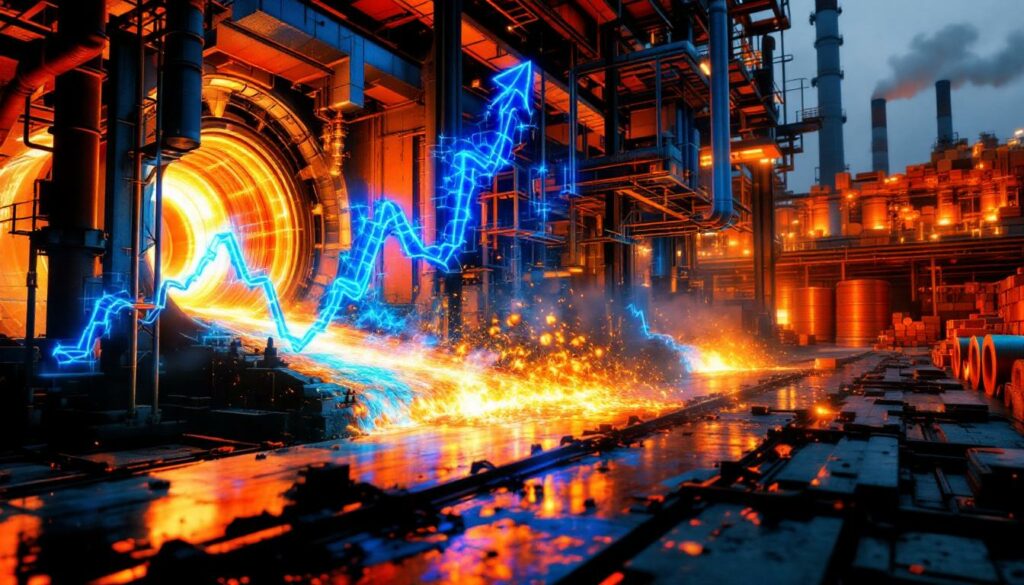Navigating the Copper Cathode Rod Market in 2025: Processing Fees and Industry Challenges
The copper cathode rod industry has experienced significant volatility in 2025, with unprecedented price movements and intensifying competition among manufacturers. This comprehensive analysis examines how the sector has evolved during the first half of the year and provides insights into what market participants can expect going forward.
What Happened in the Copper Cathode Rod Market During H1 2025?
Price Trends and Market Dynamics
Copper prices maintained substantially higher levels in Q1 2025 compared to the same period in 2024, setting the stage for a volatile market environment. The most dramatic development came in April 2025, when the market experienced an unprecedented limit-down trading event—marking a complete reversal from the upward price trajectory seen in April 2024.
This sharp price correction triggered an immediate response from buyers, who released orders earlier than planned. Production continued at elevated levels through early May as manufacturers processed this sudden influx of orders.
"The limit-down trading event in April 2025 represented a pivotal market shift, completely reversing the pattern we observed in 2024 when rising prices caused widespread order postponements," notes the SMM analysis from July 2025.
The contrast with 2024 is particularly revealing. During April-May 2024, rising copper prices prompted widespread order postponements, creating significant operating rate pressure for manufacturers. The 2025 scenario effectively inverted this dynamic, front-loading demand into the early part of Q2.
Operating Rate Performance
H1 2025 operating rates reached an average of 65.63%, representing a modest but meaningful 2.23 percentage point increase over H1 2024's 63.4%. This improvement, however, masks the significant monthly variations observed throughout the period.
April 2025 marked the peak operating rate for the first half, with manufacturers running at high capacity to fulfill the suddenly released orders. Following this surge, operating rates declined month-over-month through May and June.
By June, weekly operating rate data showed continuous deterioration as the traditional peak season concluded. This downward trend accelerated into early July, when manufacturers implemented significant production cuts in an attempt to reduce mounting inventories.
Processing Fee Competition
June witnessed unprecedented price competition among manufacturers, with processing fees dropping to zero as companies struggled to maintain market share. By mid-year, the situation had deteriorated further, with some manufacturers reporting negative processing fees—effectively selling at a loss to preserve operating rates.
Several factors contributed to this extraordinary competitive environment:
- Semi-annual target pressures forced manufacturers to maintain high operating rates despite weakening demand
- Trader involvement intensified price competition throughout the supply chain
- Inventory accumulation created desperation among producers to move product
- Structural overcapacity pressured margins across the industry
The processing fee collapse represents one of the most significant challenges facing the industry as it moves into the second half of 2025.
Why Did Processing Fees Face Such Intense Competition?
Supply-Demand Imbalance Factors
The processing fee crisis stems primarily from a fundamental supply-demand imbalance. Manufacturers maintained high production levels through Q2 despite clear signals of weakening demand, primarily driven by the pressure to meet semi-annual targets.
This led to a rapid accumulation of finished product inventories throughout June as downstream consumption slowed significantly. The inventory buildup created a vicious cycle where manufacturers reduced processing fees to move product, which further pressured margins across the industry.
High copper prices throughout Q2 compounded these challenges by:
- Discouraging new order placement from price-sensitive buyers
- Slowing the pace of existing order fulfillment as buyers delayed purchases
- Creating cash flow pressures throughout the supply chain
- Reducing manufacturers' flexibility to maintain processing fee margins
The deep involvement of traders in the market further exacerbated price competition, as these intermediaries aggressively pushed for lower processing fees to secure volume.
Raw Material Dynamics
Throughout most of 2025, the price spread between primary metal and scrap exceeded 1,000 yuan/mt, creating a significant economic advantage for secondary copper rod production. However, this theoretical advantage failed to materialize into market share gains due to persistent raw material shortages.
Secondary copper rod manufacturers faced several constraints:
- Raw material shortages limited production capacity utilization
- New regulatory policies for secondary copper remained in exploratory implementation stages
- Supply chain uncertainties reduced processors' ability to capitalize on favorable price spreads
- Quality concerns in certain applications maintained demand for primary copper cathode rod
As a result, secondary copper rod plants operated at consistently lower rates compared to 2024, despite the apparent economic advantages offered by the price spread.
Downstream Consumption Patterns
Wire and cable manufacturers—the primary consumers of copper cathode rod—showed declining operating rates as June progressed. This weakening demand was largely attributable to the front-loaded order pattern created by the April price collapse.
The early release of orders in April effectively pulled forward demand that would normally have been spread throughout Q2, creating an artificial demand vacuum by June. High copper prices in Q2 further dampened new order placement as downstream consumers adopted a wait-and-see approach.
By early July, new business was dominated by provisional pricing arrangements and forward orders as buyers attempted to manage price risk. This shift in purchasing patterns further complicated manufacturers' ability to maintain processing fee margins.
What's the Current State of the Copper Cathode Rod Industry?
Inventory and Production Challenges
Manufacturers implemented significant production cuts in early July in a direct response to mounting inventory pressures. These cuts provided only temporary relief, however, as inventory levels quickly rose again after production resumed—indicating persistent structural oversupply.
Weekly operating rates continued to underperform expectations into July, reflecting manufacturers' struggles to balance production targets with market realities. Industry sentiment remains decidedly pessimistic, with expectations that July will record the lowest operating rates for the period.
The inventory challenges reveal several structural issues within the industry:
- Production capacity significantly exceeds current demand
- Inventory management systems have failed to adapt to changing market conditions
- Coordination between production planning and sales remains suboptimal
- Destocking efforts face headwinds from weak downstream demand
These challenges highlight the need for more sophisticated inventory management strategies across the industry.
Pricing Environment
Copper prices retreated from 80,000 yuan/mt to 78,500 yuan/mt in July, representing a modest but meaningful correction. Despite this copper price retreat dynamics, the market has not seen a significant stimulation of new order placement, suggesting deeper structural issues beyond price sensitivity.
Most new business in July has come from previously arranged provisional pricing agreements and forward orders. The shipment pace remains under pressure despite price adjustments, indicating that price is not the only factor constraining demand.
The disconnect between price movements and order response points to:
- Downstream consumers managing inventory very cautiously
- Buyers expecting further price decreases
- Order deferral becoming a strategic approach for consumers
- Provisional pricing gaining popularity as a risk management tool
These dynamics suggest that price stability, rather than simply lower prices, may be necessary to restore normal ordering patterns.
Capacity Utilization Concerns
National copper cathode rod capacity is projected to reach 18.292 million metric tons by the end of 2025, creating severe overcapacity that threatens manufacturer profitability. The industry faces a fundamental imbalance between production capacity and sustainable demand.
Processing fee losses are expected to worsen through year-end as this overcapacity situation intensifies competitive pressures. The industry increasingly recognizes the need to move beyond destructive price competition toward more strategic differentiation.
"The industry must step out of price competition, find directions for self-improvement, and expand domestic and external demand channels," according to SMM's July 2025 analysis.
The capacity utilization challenges highlight the need for potential mining consolidation trends as profitability pressures mount in the second half of 2025.
How Are Primary vs. Secondary Copper Rod Markets Performing?
Comparative Economics
Secondary copper rod maintained consistent economic advantages throughout most of 2025, with price differentials between primary and secondary materials exceeding 1,000 yuan/mt. This significant spread created a theoretical competitive edge for secondary copper rod producers.
However, primary copper cathode rod faced only moderate market share pressure from secondary producers, primarily due to constraints on the secondary side rather than strength in primary demand. Raw material constraints severely limited secondary copper rod manufacturers' ability to capitalize on their price advantages.
The economic comparison reveals several important market dynamics:
- Price advantages don't automatically translate to market share gains when supply chains are constrained
- Quality and reliability considerations continue to support primary copper demand in certain applications
- Secondary copper faces both regulatory and raw material challenges that limit its competitive impact
- The theoretical economic advantage of secondary copper hasn't fundamentally altered market structure
These patterns suggest that economics alone don't determine market outcomes when structural constraints exist.
Regulatory Impact
New policies affecting secondary copper remained in exploratory implementation phases throughout H1 2025, creating uncertainty that contributed to lower operating rates for secondary copper rod producers. This regulatory ambiguity has been a significant factor limiting the sector's ability to capitalize on favorable economics.
Secondary copper raw material shortages persisted throughout the first half of the year, reflecting both domestic supply constraints and international trade complications. These shortages prevented secondary producers from operating at full capacity despite strong economic incentives.
Primary copper cathode rod has maintained its market position despite lacking price spread advantages, largely due to:
- Consistent raw material availability
- Established supply chains and customer relationships
- Quality consistency advantages in certain applications
- Greater regulatory certainty compared to secondary materials
The regulatory environment remains a critical factor shaping competition between primary and secondary copper rod producers as the market evolves.
What's the Outlook for the Copper Cathode Rod Market in H2 2025?
Production and Demand Forecasts
Industry operating rates are expected to reach their lowest levels for the period in July, with limited prospects for significant improvement in the near term. Full-year targets appear increasingly challenging as H2 begins under these difficult conditions.
Overcapacity issues are projected to intensify through year-end as new capacity comes online despite weak demand fundamentals. This structural imbalance will likely continue to pressure processing fees and manufacturer profitability throughout the second half.
Key factors that will shape H2 2025 include:
- The pace of inventory normalization
- Downstream sector operating rates, particularly in wire and cable
- Copper price volatility and its impact on order patterns
- The effectiveness of production discipline among major manufacturers
- Potential policy interventions to address overcapacity
Manufacturers face mounting profitability pressures from processing fee competition, with limited short-term solutions available to address these structural challenges.
Strategic Recommendations
The industry is increasingly urged to move beyond destructive price competition toward more sustainable strategies. Product differentiation emerges as a key recommendation, allowing manufacturers to escape pure commodity competition and establish value propositions beyond price.
Expansion of domestic and external demand channels represents another critical strategy, enabling manufacturers to diversify their customer base and reduce dependence on oversupplied market segments.
"SMM calls on the industry to step out of price competition, find directions for self-improvement, and expand domestic and external demand channels."
Self-improvement initiatives are needed to address structural overcapacity through:
- Operational efficiency improvements
- Product quality and consistency enhancements
- Supply chain optimization
- Technological innovation
- Strategic consolidation where appropriate
These strategic shifts will be essential for navigating the challenging market environment expected in H2 2025, especially given the surging copper demand in other sectors.
Market Structural Challenges
Supply chain model changes are compressing manufacturer margins through increased transparency and trader involvement. These structural shifts are making it increasingly difficult to maintain processing fee margins even as manufacturers seek to differentiate their offerings.
Increasing national capacity continues to create structural overcapacity, with the 18.292 million metric ton projection for year-end 2025 far exceeding sustainable demand. This imbalance will likely drive industry consolidation as profitability challenges mount.
Processing fee losses are expected to worsen in H2 2025 unless significant changes occur in either:
- Demand fundamentals
- Industry production discipline
- Regulatory intervention
- Market structure and competitive dynamics
The industry faces a critical inflection point that will likely reshape competitive dynamics and market structure in the coming years, making copper investment strategies particularly challenging in this environment.
FAQ: Copper Cathode Rod Market Dynamics
What caused the processing fee competition in the copper cathode rod market?
The intense processing fee competition resulted from multiple factors converging in H1 2025. Manufacturers maintained high production levels to meet semi-annual targets despite clear signals of weakening demand, creating inventory buildup that pressured pricing. Trader involvement intensified competition throughout the supply chain, while structural overcapacity fundamentally undermined pricing power. By June, these pressures drove processing fees to zero or even negative levels as manufacturers prioritized volume over margin.
How did copper price movements affect the market in H1 2025?
Copper prices in Q1 2025 were significantly higher than Q1 2024, creating challenging cost conditions for downstream consumers. The market experienced a dramatic limit-down trading event in April 2025—opposite to April 2024's upward trend. This sudden price collapse triggered early order releases and affected production planning throughout Q2. The front-loaded demand pattern created artificial strength in April-May followed by weakness in June as orders dried up. High prices throughout Q2 discouraged new order placement, complicating inventory management for both producers and consumers.
What is the capacity outlook for the copper cathode rod industry?
National copper cathode rod capacity is projected to reach 18.292 million metric tons by the end of 2025, creating severe overcapacity issues that put additional pressure on processing fees and manufacturer profitability. This capacity expansion continues despite clear signs of market saturation, suggesting that structural adjustments will eventually be necessary. The industry faces mounting calls to address this overcapacity through production discipline, consolidation, and strategic differentiation rather than destructive price competition.
How did secondary copper rod performance compare to primary copper cathode rod?
Despite economic advantages with price differentials exceeding 1,000 yuan/mt throughout most of 2025, secondary copper rod producers operated at lower rates than in 2024. This underperformance stemmed primarily from raw material shortages and regulatory uncertainty, which limited secondary producers' ability to capitalize on favorable economics. Primary copper cathode rod maintained its market position despite lacking price spread advantages, benefiting from consistent material availability, established supply chains, and quality consistency advantages in certain applications.
Further Exploration:
Readers interested in learning more about copper market dynamics can also explore detailed copper price predictions published by analysts, which offers regular analysis and insights on metal markets and industry trends. Additionally, the IEA's Critical Minerals Outlook provides valuable context on the broader minerals landscape affecting the semi-annual market review and outlook for copper cathode rod.
Want to Identify the Next Major Copper Discovery?
Discovery Alert's proprietary Discovery IQ model offers real-time notifications on significant ASX copper discoveries, giving you immediate access to potentially transformative investment opportunities before the broader market. Explore why major mineral discoveries can generate substantial returns by visiting the dedicated discoveries page and begin your 30-day free trial today.




